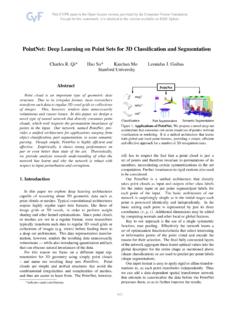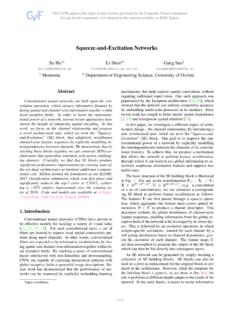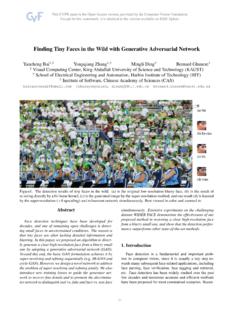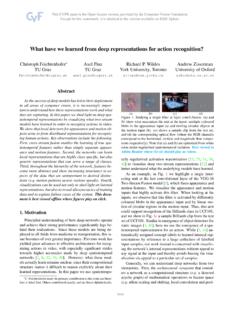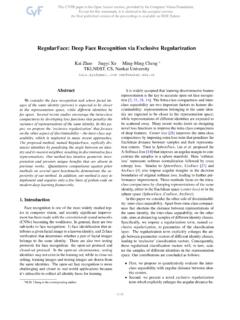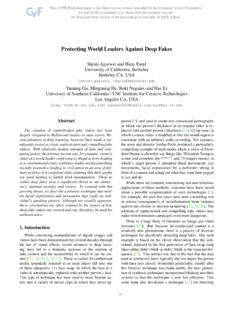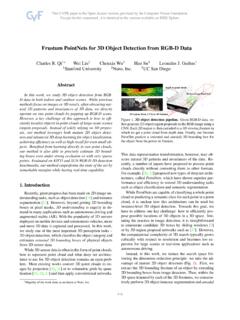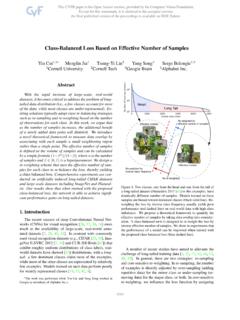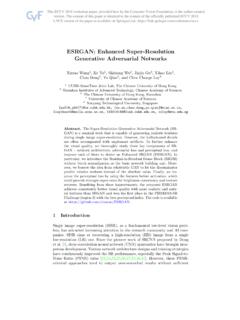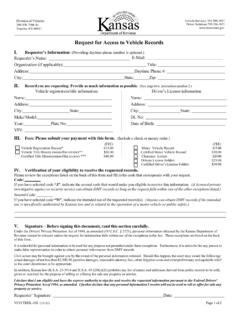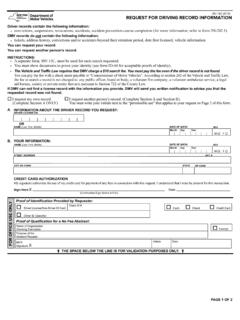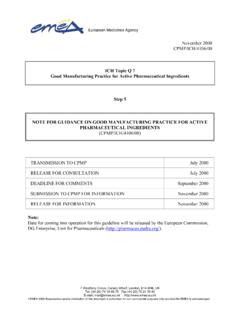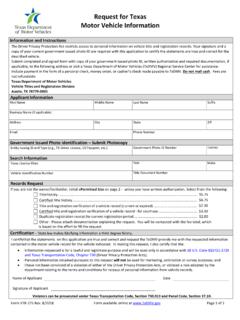Transcription of Learning RoI Transformer for Oriented ... - CVF Open Access
1 Learning RoI Transformer for Oriented Object Detection in Aerial ImagesJian Ding, Nan Xue, Yang Long, Gui-Song Xia , Qikai LuLIESMARS-CAPTAIN, Wuhan University, Wuhan, 430079, China{ , xuenan, longyang, , detection in aerial images is an active yet chal-lenging task in computer vision because of the bird s-eyeview perspective, the highly complex backgrounds, and thevariant appearances of objects. Especially when detectingdensely packed objects in aerial images, methods relying onhorizontal proposals for common object detection often in-troduce mismatches between the Region of Interests (RoIs)and objects. This leads to the common misalignment be-tween the final object classification confidence and local-ization accuracy. In this paper, we propose aRoI Trans-formerto address these problems.}
2 The core idea of RoITransformer is to apply spatial transformations on RoIsand learn the transformation parameters under the super-vision of Oriented bounding box (OBB) annotations. RoITransformer is with lightweight and can be easily embed-ded into detectors for Oriented object detection. Simply ap-ply the RoI Transformer to light-head RCNN has achievedstate-of-the-art performances on two common and chal-lenging aerial datasets, , DOTA and HRSC2016, witha neglectable reduction to detection speed. Our RoI Trans-former exceeds the deformable Position Sensitive RoI pool-ing when Oriented bounding-box annotations are experiments have also validated the flexibility andeffectiveness of our RoI IntroductionObject detection in aerial images aims at locating ob-jects of interest ( , vehicles, airplanes) on the groundand identifying their categories.
3 With more and moreaerial images being available, object detection in aerial im-ages has been a specific but active topic in computer vi-sion [3,29,36,6]. However, unlike natural images thatare often taken from horizontal perspectives, aerial imagesare typically taken from bird s-eye view, which impliesthat objects in aerial images are always arbitrary , the highly complex backgrounds and variant ap-pearances of objects further increase the difficulty of ob-ject detection in aerial images. These problems have been Corresponding author: (top) RotatedRoI warping (bottom)il-lustrated in an image with many densely packed objects. One hori-zontal RoI often contains several instances, which leads ambiguityto the subsequent classification and location task.
4 By contrast, arotated RoI warping usually provides more accurate regions forinstances and enables to better extract discriminative features forobject approached by anoriented and densely packed ob-ject detectiontask [37,31,12], which is new while well-grounded and have attracted much attention in the pastdecade [27,30,26,18,1].Many of recent progress on object detection in aerial im-ages have benefited a lot from the R-CNN frameworks [9,8,32,2,29,38,6,12,16]. These methods have re-ported promising detection performances, by using hori-zontal bounding boxes asregion of interests(RoIs) andthen relying on region features for category identifica-tion [2,29,6]. However, as observed in [37,28], thesehorizontal RoIs(HROIs) typically lead to misalignmentsbetween the bounding boxes and objects.
5 For instance, asshown in , due to the Oriented and densely-distributedproperties of objects in aerial images, several instances areoften crowded and contained by one HRoI. As a result, itusually turns to be difficult to train a detector for extractingobject features and identifying the object s accurate of using horizontal bounding boxes, orientedbounding boxes have been employed to give more accu-rate locations of objects [37,23,28]. In order to achieve2849high recalls at the phase of RRoI generation, a large num-ber of anchors are required with different angles, scales andaspect ratios. These methods have demonstrated promis-ing potentials on detecting sparsely distributed objects [26,43,27,30]. However, due to the highly diverse directionsof objects in aerial images, it is often intractable to acquireaccurate RRoIs to pair with all the objects in an aerial im-age by using RRoIs with limited directions.
6 Consequently,the elaborate design of RRoIs with as many directions andscales as possible usually suffers from its high computa-tional complexity at region classification and the regular operations in conventional networks forobject detection [8] have limited generalization to rotationand scale variations, it is required of some orientation andscale-invariant in the design of RoIs and corresponding ex-tracted features. To this end, Spatial Transformer [14] anddeformable convolution and RoI pooling [5] have been pro-posed to model the geometry variations. However, theyare mainly designed for the general geometric deformationwithout using the Oriented bounding box annotation. Inthe field of aerial images, there is only rigid deformation,and Oriented bounding box annotation is available.
7 Thus,it is natural to argue that it is important toextract rotation-invariant region featuresand toeliminate the misalignmentbetween region features and objectsespecially for denselypacked this paper, we propose a module called RoI Trans-former, targeting to achieve detection of Oriented anddensely-packed objects, by supervised RRoI Learning andfeature extraction based on position sensitive alignmentthrough a two-stage framework [9,8,32,4,10]. It con-sists of two parts. The first is theRRoI Learner, whichlearns the transformation from HRoIs to RRoIs. The sec-ond is theRotated Position Sensitive RoI Align, which ex-tracts the rotation-invariant features from the RRoI for fol-lowing objects classification and location regression.
8 Tofurther improve efficiency, we adopt a light head structurefor all RoI-wise operations. We extensively test and evalu-ate the proposed RoI Transformer on two public datasetsfor object detection in aerial DOTA [37] andHRSC2016 [28], and compare it with state-of-the-art ap-proaches, such as deformable PS RoI pooling [5]. In sum-mary, our contributions are three-fold: We propose a supervised rotated RoI learner, which isa learnable module that can transform Horizontal RoIsto RRoIs. This design can not only effectively alleviatethe misalignment between RoIs and objects, but alsoavoid a large number of anchors designed for orientedobject detection. We design a Rotated Position Sensitive RoI Align-ment module for spatially invariant feature extraction,which can effectively boost the object classificationand location regression.
9 The module is a crucial designwhen using the light-head RoI-wise operation, whichgrantees efficiency and low complexity. We achieve state-of-the-art performance on severalpublic large-scale datasets for Oriented object detec-tion in aerial images. Experiments also show that theproposed RoI Transformer can be easily embedded indifferent backbones with significant detection perfor-mance Related Oriented Bounding Box RegressionDetecting Oriented objects is an extension of general hor-izontal object detection. The task is to locate and classify anobject with orientation information, which is mainly tack-led with methods based on region proposals. The HRoIbased methods [15,37] usually use a normal RoI Warp-ing to extract feature from a HRoI, and regress position off-sets relative to the ground truths.
10 The HRoI based methodexists a problem of misalignment between region featureand instance. The RRoI based methods [30,26] usuallyuse a Rotated RoI Warping to extract feature from a RRoI,and regress position offsets relative to the RRoI, which canavoid the problem of misalignment in a certain. However,the RRoI based method involves generating a lot of rotatedproposals. The [26] adopted the method in [27] for ro-tated proposals. The SRBBS [27] is hard to be embedded inthe neural network, which would cost extra time for rotatedproposal generation. The [30,43,41,1] used a design of ro-tated anchor in RPN [32]. However, the design is still time-consuming due to the dramatic increase in the number of an-chors (numscales numaspectratios numangles).
